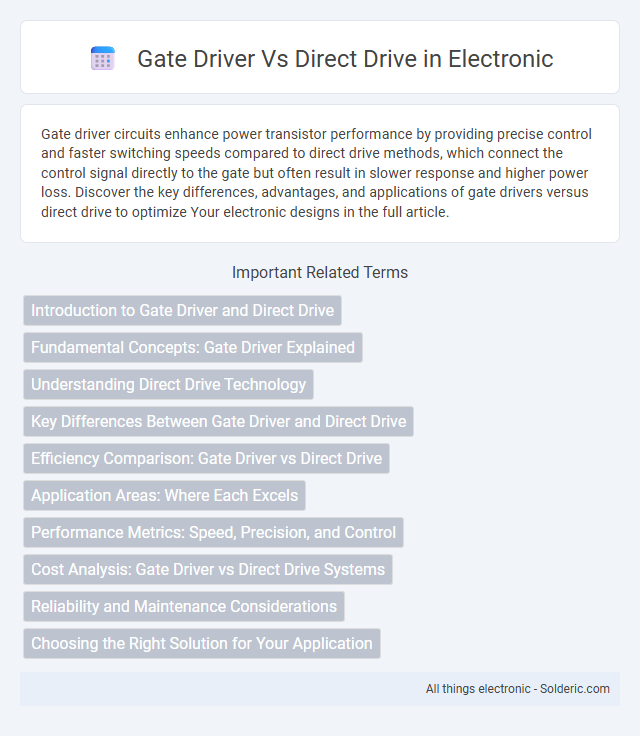Gate driver circuits enhance power transistor performance by providing precise control and faster switching speeds compared to direct drive methods, which connect the control signal directly to the gate but often result in slower response and higher power loss. Discover the key differences, advantages, and applications of gate drivers versus direct drive to optimize Your electronic designs in the full article.
Comparison Table
| Feature | Gate Driver | Direct Drive |
|---|---|---|
| Definition | Electronic circuit that controls the gate of a power transistor | Direct connection controlling the load without intermediary components |
| Function | Amplifies control signals to switch power devices efficiently | Applies control signals directly to the device |
| Switching Speed | High-speed switching with reduced delay | Lower switching speed, limited by control source capabilities |
| Power Efficiency | Improves efficiency by reducing switching losses | Lower efficiency due to possible signal attenuation and losses |
| Complexity | Higher complexity, requires additional circuitry | Simpler design with fewer components |
| Cost | Higher cost due to extra components and design complexity | Lower cost with minimal components |
| Applications | Used in power electronics, motor control, and switching power supplies | Suitable for low-power or simple switching applications |
| Protection Features | Often includes built-in protections like short-circuit and undervoltage lockout | Limited or no protection features |
Introduction to Gate Driver and Direct Drive
Gate drivers are specialized electronic circuits designed to efficiently switch high-power transistors such as MOSFETs or IGBTs, enabling precise control of voltage and current in applications like motor control and power conversion. Direct drive refers to a method where the motor is driven directly by applying current or voltage without intermediary switching devices, often resulting in simpler design but less control and efficiency. Understanding the distinction between gate driver circuits and direct drive systems is crucial for optimizing performance in power electronics and electric motor applications.
Fundamental Concepts: Gate Driver Explained
A gate driver is an essential electronic circuit that controls the voltage and current supplied to the gate of a power transistor, enabling efficient switching and minimizing losses. Unlike direct drive, where the control signal powers the transistor gate directly, gate drivers provide level shifting, voltage amplification, and isolation, ensuring reliable and precise operation of MOSFETs or IGBTs in high-speed applications. Fundamental concepts of gate drivers include their role in enhancing switching performance, reducing electromagnetic interference, and protecting devices from voltage spikes and latch-up conditions.
Understanding Direct Drive Technology
Direct drive technology eliminates intermediate components by connecting the motor directly to the load, enhancing efficiency and reducing mechanical complexity. Gate drivers, conversely, control power transistors to manage motor switching but introduce added layers between control signals and motor operation. Understanding direct drive technology allows you to optimize performance in applications requiring precision, reliability, and reduced maintenance.
Key Differences Between Gate Driver and Direct Drive
Gate drivers provide precise voltage and current control to switch semiconductor devices efficiently, improving performance and protecting components, whereas direct drive systems apply input signals directly without amplification or conditioning. Gate drivers enhance switching speed and reduce power loss in applications like motor control and power inverters, while direct drive simplifies circuitry but may suffer from slower response and lower efficiency. Choosing between them depends on Your need for control accuracy, power efficiency, and application complexity.
Efficiency Comparison: Gate Driver vs Direct Drive
Gate drivers enhance efficiency by providing precise voltage and current control to power transistors, minimizing switching losses and enabling faster and smoother transitions. Direct drive systems, lacking specialized control circuitry, often experience higher conduction and switching losses due to less optimized gate voltage levels. Overall, gate drivers improve power conversion efficiency and thermal performance compared to direct drive configurations.
Application Areas: Where Each Excels
Gate drivers excel in high-frequency switching applications such as power converters, motor drives, and electric vehicles, offering precise control and efficiency. Direct drive systems perform best in low-speed, high-torque applications including robotics, CNC machines, and turntables, providing simplicity and reduced mechanical losses. Each technology suits distinct industry needs based on speed, torque, and control complexity requirements.
Performance Metrics: Speed, Precision, and Control
Gate drivers enhance switching speed and precision by providing stable voltage and current to MOSFETs or IGBTs, enabling rapid and accurate transistor control. Direct drive methods often lack the fine-tuned control and efficiency found in gate driver circuits, resulting in slower switching speeds and reduced precision. Your application benefits from gate drivers through improved control, higher efficiency, and faster response times compared to direct drive systems.
Cost Analysis: Gate Driver vs Direct Drive Systems
Gate driver systems typically involve higher initial costs due to the need for specialized driver circuits and components, but they offer improved efficiency and reduced power losses over time. Direct drive systems have lower upfront expenses since they eliminate complex driver hardware, making them cost-effective for simple or low-power applications. Total cost of ownership favors gate drivers in high-performance scenarios where energy savings and reliability reduce maintenance and operational costs.
Reliability and Maintenance Considerations
Gate drivers enhance reliability by providing precise control over power transistors, reducing switching losses and thermal stress, which extends component lifespan and lowers maintenance frequency. Direct drive systems, while simpler, may experience higher wear and increased failure risk due to lack of protective regulation, leading to more frequent maintenance and potential downtime. Your choice between gate driver and direct drive should weigh the long-term reliability benefits and reduced maintenance costs offered by gate driver technology.
Choosing the Right Solution for Your Application
Selecting between a gate driver and direct drive depends on your application's switching speed, efficiency, and complexity requirements. Gate drivers enhance MOSFET or IGBT performance by providing precise voltage and current control, reducing switching losses and electromagnetic interference. Direct drive may suit simpler circuits with lower switching demands but often lacks the protection and optimization features critical for high-performance electronic systems.
Gate driver vs Direct drive Infographic

 solderic.com
solderic.com